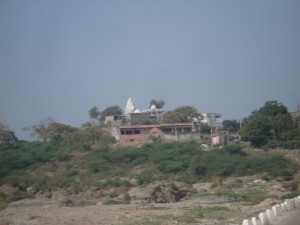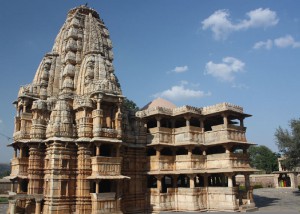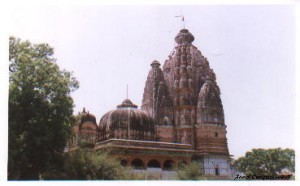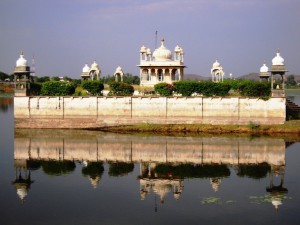Tourist Attraction Of Dungarpur
Dungarpur is a city in the southernmost part of Rajasthan state of India. It is the administrative headquarters of Dungarpur District. The rail line between Udaipur and Himatnagar in Gujarat runs through the town, shortest distance to the National Highway 8 from Dungapur town is 20 km.
Baneshwar Tample
The Beneshwar temple containing the most reverend Shiva Linga of the area is situated on a delta formed at the confluenced of Som and Mahi rivers, about one and a half km from Nawa Tapra village. Sabla is the nearest bus stand located at a distance of about 7 km from the temple on Udaipur-Banswara-Dungarpur bus route. Sabla is at a distance of 123 km from Udaipur, 53 km from Banswara,45 km from Dungarpur and 22 km from Aspur. The tribal in character, a fair at the temple is held during Magh shukla Ekadashi to Magh Shukla Purnima. Just near the Beneshwar temple is the Vishnu temple which was reportedly constructed in Samwat 1850 (1793A.D.).

The Juna Mahal was built in the 13th century A.D. and is a seven-storied building that almost looks likes a fortress; with its turrets, crenellated walls, corridors and very thin entrances. But the interiors are pleasingly designed with glass and mirror work, frescoes and miniature paintings.
Govt. Museum
The Rajmata Devendra Kunwar Government Museum is the perfect place to look out for specimen and evidence of the rich past of Dungarpur. The collection showcases the old culture and civilization of the Vagad area. Some of the attractions include metal statues, statues of deities, small paintings, stone inscriptions and coins belonging to the 6th centuryA.D.; displayed in three galleries.
The first gallery showcases antiques that were collected from the Vagad area as wells as various statues collected from places like Galiyakot, Amjhara and Baroda; that belonged to the Gupta period. There are statues of Trantrik Ganesh, Brahmi wearing deer hide, Shiva holding a veena, Padmidi, Padmapani yaksha, Vaishnavi riding Garuda, Kumar, Kaumari, Panala, Adinath in meditation position, half sized statue of Sura-Sundari, Laxminarayan riding on Garuda, the Kuber couple, Mahishasurmardini and various other statues of the Jain culture. The second gallery houses Kutub Minar and Vijay Stambh made from postage stamps. The third gallery contains inscriptions that were collected from Vagad area. Other displays include terrakota idol sculpture of Molela, oil paintings, various photographs of the structures of Dungarpur and other items.
Badal Mahal
The Badal Mahal is located at one side of the Gaibsagar and is very famous for its intricate designs. Built of dawra stone, the Mahal was built in two stages: Maharawal Gopinath built the ground floor and verandah and Marahawal Punjraj built the first floor and domes later. Each of the three minor domes has a construction representing a half ripe lotus, at the top; the largest dome of Badal Mahal has three such constructions. Different styles of architecture define this palace including the Rajput style, Dungarpur style and Mughal style.
Dev Somnath Temple
Located some 25 km from Dungarpur, the Dev Somnath Temple is the only temple in the whole world that is made of only stone, without any kind of packing material like sand, lime etc. It is located on the banks of the Som River in the Dev Village. Built in the 12th century A.D. by the Sompuras, this three-storey structure is standing on 150 pillars with each pillar displaying the Takshan style. The pillars are made of stone and have several unclear writings on it.
The temple can be entered from north, south and east. Some of the attractions include idols of dancers, arches as well as the entrances themselves. The main temple has a dark black stone Shiva Linga located at the center of a base made of white stone. This Shiva Linga is an exact copy of the one in the Somnath Temple located in Gujarat.
Shrinathji Temple
Maharawal Punjraj originally built this temple and he performed the consecration or pratishthapan of the temple in 1623 A.D. The prime attractions of the temple are the statues of Shri Radhikaji and Goverdhannathji. It is believed from the Pushti Marg writings, that it was Shri Vallabhacharya’s son, Goswami Shri Vitthalnath, who inspired Shri Punjraj to construct this temple.
The temple has a gallery situated along with the main temple. There are also medium sized temples that are dedicated to Shri Baake Bihariji and Shri Ramchandraji, along with the main temple. A three-storey hall or Goodh Mandap, that is standing on 64 legs and 12 pillars, is present here, that serves all the three temples. The main temple has a compound along with 16 west faced temples, 16 east faced temples and 4 north faced temples, dedicated to minor deities.
Gaib Sagar
This manmade lake was originally built by Maharaj Gopinath or Gaipa Rawal in 1428 A.D. and has always been a great symbol of pride for the local people. The lake has many mentions in various literature pieces and historical evidences. A large number of local legends and stories are closely associated with this lake.
Gaipa Rawal had built the Bhaga Palace towards the backside of the lake and the Badal Mahal in the center. There is also the popular shrine of Shrinathji that lies next to it. The lake had witnessed many renovation attempts from time to time and the biggest renovation took place under the rule of the 27th Maharawal of Dungarpur, Maharawal Shiv Singh. The lake is also a holy place for the local people, who carry out various religious rituals in the lake.







